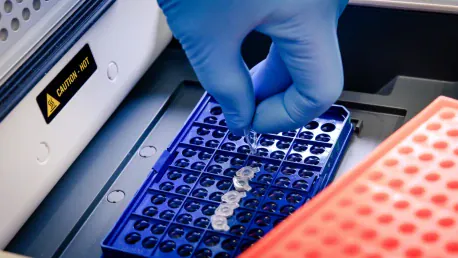The realm of bioprinting has witnessed a momentous development thanks to a team of innovative researchers at Penn State University. This scientific group has pioneered an advanced bioprinting technique that employs spheroids—clusters of cells—to fabricate complex tissue with enhanced precision and scalability. This groundbreaking method, known as the High-throughput Integrated Tissue Fabrication System for Bioprinting (HITS-Bio), achieves tissue production at speeds ten times faster than existing technologies. This significant breakthrough promises substantial strides for the advancement of regenerative medicine, including the building of organs for transplantation, the study of disease progression, and the screening of new pharmaceutical drugs.
The Promise and Challenges of Bioprinting
Three-dimensional (3D) printing has long been envisioned as a transformative technique not only for manufacturing an array of material products but also for its tremendous potential in replicating human tissues. This capability holds far-reaching implications for human health and medical treatments. However, the road to progress in bioprinting, particularly in printing high-density tissues at scale, has encountered numerous obstacles mainly due to the limitations inherent in existing technologies. These traditional methods frequently lack the needed precision and scalability to efficiently produce functional tissues.
The researchers at Penn State devised the HITS-Bio system to transcend these challenges. With spheroids possessing a cell density closely mirroring that of human tissue, they serve as an effective alternative for achieving the required density for functional tissue. The precision and scalability of HITS-Bio are realized through a digitally controlled nozzle array incorporating multiple nozzles that operate dynamically in three dimensions. This innovative configuration allows scientists to manipulate several spheroids concurrently, accurately placing them on a bioink substrate at a remarkable speed.
The Mechanics of HITS-Bio
Ibrahim T. Ozbolat, who holds the prestigious Dorothy Foehr Huck and J. Lloyd Huck Chair in 3D Bioprinting and Regenerative Medicine, and serves as a professor at Penn State, heralded this development as a significant advancement. He asserted that this new technique represents a substantial leap forward in the realm of rapid bioprinting of spheroids, facilitating high-throughput tissue production at markedly faster rates than existing methodologies while preserving high cell viability. Essentially, bioprinting involves the construction of 3D structures from living cells and biomaterials. Cells encapsulated in substrates such as hydrogel form a bioink that gets printed layer by layer using specialized printers. Over a period extending several weeks, these cells grow, proliferate, and eventually mature into 3D tissue structures.
The HITS-Bio technique notably addresses the key limitations of conventional bioprinting methods. Traditional bioprinting often imposes harm on the delicate cellular structures during the printing process, resulting in cell death. Furthermore, they typically do not afford precise control over the movement and placement of spheroids, a critical requirement in replicating functional human tissue. The ability of HITS-Bio to print multiple spheroids simultaneously expedites the production process while ensuring higher cell viability. This capability is crucial for generating functional and clinically relevant tissues.
Testing and Applications of HITS-Bio
To demonstrate the effectiveness of their platform, the research team undertook the fabrication of cartilage tissue. They successfully created a one-cubic centimeter structure made up of approximately 600 spheroids derived from cells capable of forming cartilage. Remarkably, this fabrication was completed in under 40 minutes, an impressive feat that surpasses the capabilities of current bioprinting technologies. The team further showcased the potential applications of the HITS-Bio technique for on-demand tissue repair in surgical settings, using a rat model. In a groundbreaking instance, they printed spheroids directly into a wound site in the skull during surgery, marking the first occurrence of intraoperative spheroid printing.
By employing microRNA technology to program the spheroids, the researchers could transform the cells into bone, substantially hastening the healing process. The wound exhibited 91% healing after three weeks and increased to 96% after six weeks. This development paves the way for creating complex and functional tissue in a more scalable and efficient manner, presenting new possibilities for bioprinting in medical and surgical applications.
Future Prospects and Collaborative Efforts
Researchers at Penn State University have made a significant breakthrough in the field of bioprinting. Their innovative team has developed a cutting-edge bioprinting technique that uses spheroids, which are clusters of cells, to create complex tissue with enhanced precision and scalability. This new method, called the High-throughput Integrated Tissue Fabrication System for Bioprinting, or HITS-Bio, enables tissue production at speeds that are ten times faster than existing technologies. This landmark advancement holds great promise for the future of regenerative medicine. The potential applications are vast, including the creation of organs for transplantation, studying the progression of diseases, and screening new pharmaceutical drugs. The acceleration in tissue production and the improved accuracy provided by HITS-Bio could revolutionize how we approach medical treatments, offering a new level of efficacy and speed. This technique is poised to pave the way for significant medical advancements, making treatments more effective and widely accessible.









